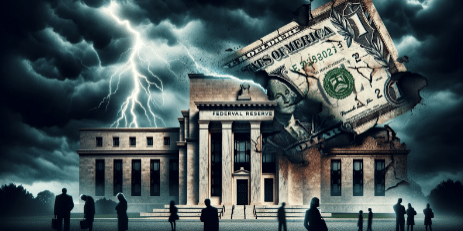
Fed's Inflation Target in Sight, but Real Economy Shows Cracks
In September, inflation nudged upward to 2.1%—closer to the Federal Reserve’s elusive 2% target but still a troubling sign for those who live in the real economy, far removed from the idealistic projections and hopes of central bankers. This modest uptick, detailed in the Commerce Department’s latest report, might appear benign at first glance, but look closer, and you’ll see a system finely balanced on hope rather than resilience.
The personal consumption expenditures (PCE) price index, the Fed’s chosen inflation gauge, showed a 0.2% monthly rise, tallying a 2.1% increase over the past 12 months. Meanwhile, core inflation—which strips out food and energy, two categories with constant price hikes that most of us still pay for—rose by 2.7%. That’s a hair above predictions and underscores the shaky nature of our so-called "stable" economy. And yet, this uptick hasn't deterred investors, who are banking on yet another rate cut from the Fed at its upcoming meeting.
This inflation report arrives amid an economic paradox: housing prices edged up by 0.3% while energy prices dropped by 2%. Goods prices, interestingly, have even shown outright deflation four times in the last five months. Is this variability a sign of a steady hand at the Fed’s wheel? Hardly. If anything, it illustrates the unpredictability of an economy driven by interventionist policies that respond more to short-term optics than sustainable growth.
For the Fed, inflation near the target seems like a victory. Yet, the reality is grimmer, especially for the American worker. The Labor Department reported that initial jobless claims fell to 216,000 for the last week of October, a drop of 12,000 from the previous period and below projections. While this signals stability, it also reflects a labor market where layoffs may be low, but wage growth remains sluggish and tenuous.
Consumer spending—a backbone of economic stability—rose by 0.5%, yet the personal saving rate dipped to 4.6%, the lowest it’s been this year. Americans are stretching their dollars thin, and as prices rise modestly, so does the debt load for households trying to keep up. And in yet another cautionary metric, the employment cost index for the third quarter showed a 3.9% annual rise in wages and benefits, eclipsing the consumer price index’s increase of just 2.4%. This tells us that while employers may be shelling out more in compensation, inflation is outpacing the wage gains that actually help people get ahead.
These metrics reveal an economic framework hanging by a thread of rate cuts, consumer credit, and inflated optimism. This, my friends, is not sustainable, and history reminds us that the Fed’s track record of targeting inflation has often led to unforeseen consequences that land hardest on regular citizens.
If you’re looking to protect yourself from these volatile shifts, I recommend downloading 7 Steps to Protect Yourself from Bank Failure—a free guide that will help you safeguard your hard-earned savings in a system ripe for instability. Don’t just rely on the Fed’s balancing act; take control of your financial future.
Ready to protect your wealth? Access the guide here: 7 Steps to Protect Your Account from Bank Failure. For even deeper insights, consider joining Bill Brocius' Inner Circle newsletter. With Bill’s unmatched expertise, you’ll gain access to actionable steps that protect your assets from the inevitable economic storm ahead.
The financial market is crumbling and EVERYONE will be affected. Only those who know what's going on and PREPARE will survive... dare we say thrive. Our 7 Simple Action Items to Protect Your Bank Account will give you the tools you need to make informed decisions to protect yourself and the ones you love.









